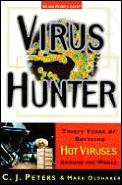I just read the chapters in Virus Hunter: Thirty Years of Battling Hot Viruses Around the World about the Ebola outbreak in monkeys in Reston Virginia in 1989. The principal author, C. J. Peters, is one of the rare breed of physicians who has chosen to specialize in virology, and especially in research on rare and emerging viral diseases.
The outbreak was in monkeys that were in quarantine after being imported to the United States for medical research. They had been imported from the Philippines, and the variety of Ebola that came from the Philippines was different from the several African varieties that are known. The differences seem to be very important. It seems clear that the virus in Reston was able to travel in the air from room to room in the facility (via the air conditioning) and infect monkeys by air; the African varieties appear to require contact with fluids (blood, urine, feces, vomit, mucus) from an infected person (after an incubation period).
The monkeys in holding were also suffering from an epidemic of another fatal simian hemorrhagic virus (SIV). All 500 monkeys in the facility were euthanized and the facility was cleaned. A second epidemic in new shipments of monkeys was similarly infected. Efforts to eliminate the infection from the source of the infected animals in the Philippines seem to have failed.
It was discovered after the fact that four of the employees of the facility carried antibodies to the Reston variety of Ebola in their blood, indicating that they had been infected. None appeared to have clinical illness. Apparently the variety of the virus that hit Virginia did not make people sick, although it was deadly to monkeys. That was great good luck for the USA!
The book makes clear that the veterinarian in charge of the Reston facility did a great job, recognizing that something was seriously wrong and keeping the monkeys in place after the mandatory 30 day quarantine. So too, the company owning the monkeys was willing to take a half million dollar loss sacrificing the monkeys and was willing to move quickly to limit the epidemic. Had the sick monkeys been sent around the country, the loss of animals might have been much greater.
I was impressed at how lucky we were that the epidemic occurred close for Fort Detrick, the site of the U.S. army's medical research command. Peters had previous experience with Ebola in Africa, and the command had a full spectrum of experts needed to identify the virus and construct new diagnostic tests. It had one of the only two facilities in the country in which the virus could be studied (relatively) safely. And it had linkages with the CDC which had the epidemiological staff and skill to follow up the disease in humans.
In the United States there are many agencies with responsibilities for health and safety. Thus Virginia and Maryland state public health officials were involved. The military has medical facilities, including those needed to transport servicemen with infectious diseases and to hospitalize them in quarantine. There are federal agencies responsible for assuring the safe disposal of medical waste, etc. The chapter gives a brief but informative summary of how complex it is to manage investigation of a new epidemic, especially one of an emergent disease.
The fundamental point is that the Reston Ebola outbreak was in many ways unique. However, such dangerous but unique outbreaks of (emergent) diseases occur relatively frequently. The country needs the dedicated and brave folk with the expertise to deal with them.

No comments:
Post a Comment